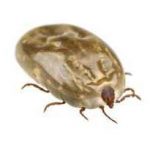Tick is the common name for the small arachnids that, along with mites, constitute the order Acarina. Ticks are ectoparasites (external parasites), living by hematophagy on the blood of mammals, birds, and occasionally reptiles and amphibians.
Ticks are important vectors of a number of diseases.


